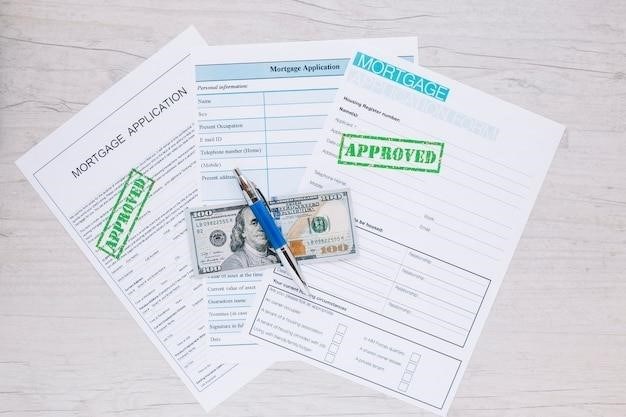Commonwealth Bank Discharge Authority Form PDF⁚ A Comprehensive Guide
This guide provides a detailed overview of the Commonwealth Bank’s Discharge/Refinance Authority Form, a crucial document for releasing property security on home loans. It covers the form’s purpose, usage, required information, online submission, processing times, and alternative methods. We’ll also address potential challenges and offer helpful resources and FAQs.
Understanding the Discharge/Refinance Authority Form
The Commonwealth Bank’s Discharge/Refinance Authority Form is a critical document used to formally release the mortgage or security held on a property by the bank. This form is essential when a borrower has fully repaid their home loan, sold the property, or is refinancing their mortgage with a different lender. The form acts as official authorization for the bank to release its claim on the property, enabling the transfer of ownership or the commencement of a new loan. It streamlines the process, ensuring a clear and legally sound transfer of ownership or refinancing arrangement. The form’s importance lies in its role as irrefutable proof of authorization, safeguarding both the borrower and the bank from potential disputes or complications. Its proper completion is crucial for a smooth and efficient transaction, avoiding potential delays or complications in the process. Accurate and complete information is essential for timely processing.
Purpose and Usage of the Form
The primary purpose of the Commonwealth Bank’s Discharge/Refinance Authority Form is to provide formal authorization for the bank to release its claim on a property used as security for a home loan. This authorization is necessary under various circumstances. For instance, if a borrower has fully repaid their loan, the form allows for the complete discharge of the mortgage, freeing the property from the bank’s lien. Similarly, if the property is sold, the form facilitates the transfer of ownership by releasing the bank’s claim. In refinancing scenarios, the form authorizes the bank to discharge the existing mortgage to allow for a new loan with another lender to be registered against the property. The form’s usage is crucial in ensuring a clear and legally sound process for all parties involved. Its standardized format and clear instructions help to minimize ambiguity and potential disputes. The form ensures a streamlined and efficient process, protecting both the borrower and the bank’s interests.
When is the Form Required?
The Commonwealth Bank’s Discharge/Refinance Authority Form becomes essential in several key situations related to home loans secured by property. It’s required when a borrower completely repays their home loan and seeks to have the mortgage formally discharged from the property title. This ensures the property is free and clear of any bank liens. The form is also necessary when refinancing a home loan. In this case, the existing mortgage must be discharged before a new mortgage with a different lender can be registered. Furthermore, if a borrower sells the property, the form is crucial to release the bank’s claim, allowing for the smooth transfer of ownership to the buyer. The form may also be required in less common scenarios, such as if there’s a change in borrowers or a significant modification to the loan agreement impacting the security. Understanding when this form is needed prevents delays and ensures a compliant and efficient process for property title transfers and loan discharges.
Key Information Required in the Form
Completing the Commonwealth Bank’s Discharge/Refinance Authority Form accurately is crucial for timely processing. The form necessitates precise details about the property used as security for the loan, including the full address and property identification details. Borrower information is essential, requiring full names, addresses, and contact details for all individuals involved in the loan agreement. Loan specifics are paramount, demanding the loan account number, original loan amount, outstanding balance, and the intended purpose of the discharge (full repayment, refinancing, or sale). Furthermore, the form typically requires details regarding the intended recipient of the discharge, whether it’s the borrower, a new lender, or a solicitor acting on the borrower’s behalf. Accurate and complete provision of all requested information minimizes delays and ensures the smooth and efficient processing of the discharge or refinance request. Any discrepancies or missing information may lead to processing delays or rejection of the application.
Online Submission and Alternatives
The Commonwealth Bank’s streamlined online Discharge/Refinance Authority Form offers a convenient alternative to the traditional paper-based method. Submitting the form online typically involves completing the digital version, uploading supporting documentation, and electronically signing the form. This process reduces paperwork, accelerates processing times, and allows for immediate confirmation of submission. However, if online submission isn’t feasible, alternative methods may include submitting a printed, completed form via mail or fax. Contacting the bank directly to inquire about other options is recommended, particularly for complex situations or specific circumstances. The availability and suitability of alternative methods may depend on individual circumstances and the bank’s current operational procedures. While the online method offers efficiency, individuals should confirm the bank’s preferred submission method before initiating the process to avoid potential delays or complications. Always retain copies of all submitted documentation for your records.
Processing Time and Expected Delays

The processing time for a Commonwealth Bank Discharge/Refinance Authority Form can vary depending on several factors. These include the completeness and accuracy of the submitted information, the complexity of the loan, and the bank’s current workload. While the bank aims for efficient processing, unforeseen delays can occur. For full loan repayments (full release), the bank may require a minimum processing period, potentially impacting overall turnaround time. To minimize delays, ensure all necessary information is accurately provided and supporting documentation is complete and readily available. Contacting the bank directly to inquire about the expected processing time for your specific circumstances is advisable. Additionally, be aware that peak periods or system issues may cause temporary delays beyond the bank’s typical processing time. Proactive communication with the bank can help manage expectations and address any potential delays promptly. Keeping track of your application’s progress and promptly addressing any requests for further information from the bank can contribute to faster processing.
Contacting Commonwealth Bank for Assistance
If you encounter difficulties completing the Commonwealth Bank Discharge/Refinance Authority Form or require assistance during the process, several avenues are available for support. The bank’s website may offer FAQs and online help resources that address common queries. Alternatively, you can utilize their telephone banking service, dialing 1300 652 220 (as indicated in some online sources), to speak directly with a representative. This allows you to clarify any uncertainties, request clarifications regarding the form’s completion, or inquire about the status of your application. For more complex issues or if you require personalized guidance, consider making an appointment at a local branch. In-person assistance may be beneficial for situations needing detailed explanations or for those who prefer a face-to-face interaction. Remember to have your loan details readily available when contacting the bank to expedite the assistance process. Utilizing these contact methods effectively can ensure a smoother and more efficient experience when dealing with the Discharge/Refinance Authority Form.
Locating the Form Online
Finding the Commonwealth Bank’s Discharge/Refinance Authority Form online might require some navigation. While a direct link isn’t readily apparent in the provided text, the bank’s official website is the primary place to begin your search. Look for sections related to home loans, refinancing, or property discharge. The website’s search function can be invaluable; try searching terms like “discharge authority form,” “refinance authority form,” or “mortgage discharge form.” The form might be located within a section dedicated to forms and documents, often categorized by product or service. If you can’t find it directly, consider using the bank’s online help or FAQ section. These resources may provide a link to the form or offer alternative methods for requesting a discharge. Remember, the form’s online availability might vary over time, so persistence and thorough searching are key. If online searches prove unsuccessful, contact the Commonwealth Bank directly via phone or in-person at a local branch for guidance on obtaining the necessary documentation.
Alternative Methods for Discharge

While the Commonwealth Bank Discharge/Refinance Authority Form is the standard method, alternative approaches exist for discharging a mortgage. Direct communication with the bank’s home loan department is crucial. A phone call or in-person visit to a branch might be necessary to explore options if online resources prove insufficient. The bank may offer alternative forms or processes, especially for unique circumstances. For instance, if you’re facing difficulties completing the online form, a bank representative can guide you through an alternative procedure. Remember to clearly explain your situation and the reason for seeking a mortgage discharge. In some cases, a solicitor specializing in property law might be helpful in navigating the process, particularly for complex situations or if you require additional legal advice concerning the mortgage release. They can act as an intermediary, ensuring all the necessary steps are taken to successfully discharge the mortgage. However, engaging a solicitor will likely involve additional costs.
Potential Challenges and Solutions
Completing the Commonwealth Bank’s Discharge/Refinance Authority form might present challenges. Incomplete or inaccurate information is a common hurdle, delaying processing. Double-check all details before submission. Ensure all required documentation is attached; missing documents significantly prolong the process. If you’re refinancing, gather all necessary information for the new loan beforehand. Technical issues with the online form are also possible. Try clearing your browser cache and cookies, or using a different browser. If problems persist, contact the bank’s IT support or use an alternative submission method. Delays in processing can be frustrating. Be proactive; follow up after a reasonable period. If the processing time exceeds expectations, politely inquire about the status. Unforeseen complications with property titles or outstanding debts could delay discharge. Work with your solicitor or the bank to resolve any title issues promptly. Addressing outstanding debts before applying is advisable to avoid further delays. Remember, clear communication with the bank is paramount in overcoming challenges and ensuring a smooth discharge process.
Additional Resources and FAQs
For further assistance with the Commonwealth Bank Discharge/Refinance Authority form, explore the bank’s official website. Their help section often contains FAQs and detailed guides on completing the form and addressing common issues. Consider contacting a mortgage broker; they possess extensive knowledge of loan processes and can offer valuable support in navigating the complexities of discharge. Solicitors specializing in property law are another excellent resource. They can provide expert advice and assistance, especially if you encounter legal or complex title issues. Online forums and communities dedicated to Australian home loans might offer insights from individuals who have previously completed the process. Remember to verify information found on these platforms with official sources. Frequently asked questions typically center on processing times, required documentation, and handling errors. The bank’s website usually addresses these, providing estimated processing times and a checklist of necessary documents. Understanding the form’s structure and purpose will significantly aid in successful completion. Don’t hesitate to contact the bank directly if you have specific concerns or encounter difficulties you can’t resolve using available resources. Proactive communication is key to a smooth experience.

No Responses